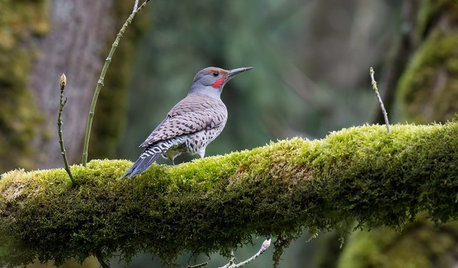Help - Growing large trees from seed (and keeping them healthy).
Amy z6b
7 years ago
last modified: 7 years ago
Featured Answer
Sort by:Oldest
Comments (17)
User
7 years agolast modified: 7 years agoAmy z6b
7 years agolast modified: 7 years agoRelated Discussions
How do YOU keep your perennial bed healthy under a tree?
Comments (8)I had the same problem trying to grow things under a sycamore here. I became too busy with things and couldn't take care of the bed well (with watering mainly) and so scrapped the bed. There is still a strip inbetween the tree and the foundation though, just not directly under it any more. You are not alone, I also found the tree slurped up a lot of nutrients from the surrounding soil. Seriously, some pockets of soil underneath looked devoid of any nutrients. The problem I had was that most of the plants did indeed seem to need yearly feedings to keep from noticeably dwindling in size. There is only so much compost one can put on that sort of bed, especially since too much build up of the soil won't exactly be good for the tree and the roots and "smother" them if too much is used. The strip I have is also getting tapped out in the nutrient department, though I composted it generously the fall before last. I'm going to get some good organic fertilizer for this area and give them a helping in those years I am not able to compost. Liquid fish fertilizer is also a pretty easy way to give them a booster. Alfalfa pellets did okay, but I'm not sure that alone would be enough. Ps. it is not impossible to grow under trees. I had several plants that did surprisingly well there, with regular watering and a bit of nutrient supplements from time to time. Epimedium, Cymbalaria, Omphaloides (surprising), Polygonatum, certain Geraniums, to name a few. Sometimes in "difficult" areas I plant somewhat invasive spreaders, since they are kept more in check in this situation. Carex morrowii, variegated ribbon grass, Ajuga, creeping jenny, Dicentra (formosa I think it was), Limelight Artemesia, Lamium, etc. It's just a matter of finding what what works well for you and a little extra upkeep... Just my thoughts anyway! CMK...See Moregrowing trees from seeds or roots
Comments (12)Here's a pic of a tree that I always thought was a Gumbo Limbo. Then it bloomed little white fragrant flowers. Now it is full of berries - they remind me of Chinaberry berries - Take a look: Here's a couple more Gumbo Limbos in the yard across the road on Chokoloskee: I strained to look, but no berries on these I just wanted to give ya a good shot of the trunk, since foliage is so deceptive. Anyways, I had some volunteer seedlings pop up and thought they sure looked like they would grow up to be trees. The mahagony trees had all their seed pods burst, so that's what I figured these would be. But now I'm wondering if they are Gumbo Limbo babies. Denise, did you visit E.C. and Chokoloskee while the Royals were all blooming? I did an experiment one day during a bike ride on the island, and no matter where I was - if I looked in any direction, I would see Royal Poiniciana blooms. Oh, by the way, the Coral Salvias that I grew from the seeds you sent me started blooming even as tiny infants...I love them and keep forgetting to write and thank you for your generosity! Okay, back to the Gumbo Limbo thing about growing them from cuttings - after Andrew, apparently a big landmark Gumbo was ripped apart and people took its limbs and stuck them into the ground, for posterity. When we bought our trailer in '96, there were 4 nice niced Gumbos from this famous tree surrounding our porch. But boy, were they interesting with their odd-shaped and contorted trunks! I was so proud to have them in the yard. I thought that was the only way they were grown, from cuttings; as I'd never seen any seeds. Then in '05, they endured the winds and rising flood waters from Wilma. When I was told we had winds up to 175 mhp, I didn't believe it because the Gumbos were still standing. Ours had been drastically pruned before we evacuated because they were so close to the house; but others on the island were still standing (like these in my pics) and I don't know of any that actually fell. I'll have to investigate this phenomenon further and see how many cutting-trees from the famous Andrew tree were able to endure Wilma winds. Denise, we have a yellow Royal Poincianna that is blooming now that will also have seed pods. Would you like me to send some? Susie...See MoreAlmost time to grow tree peonies from seeds
Comments (5)I asked a question of Carol Adelman about planting tree peonies in pots, ordered a very short tree from them and was concerned about being able to see the blooms since it's a droopy bloom one (Alice Harding). She said it was the constant freezing and thawing that is the culprit rather than just the cold. Our winters here are bad that way, lots of snow followed by very mild temps and lots of sunshine. After her email response I decided to just plant Alice H near a 3' retaining wall rather than try the pot since I couldn't put a pot anywhere that it wouldn't freeze/thaw/repeat. Seems to work well for some gardeners if they're put in an unheated garage, too, don't have room in mine!...See MoreGrowing Theobroma cacao trees from seed.
Comments (15)Lorenzo...85 farenheit is degrees...usually expressed as "85 degrees farenheit". Cacao has been the easiest tropical fruit seed, besides cherimoya, to germinate. If you have access to fresh, meaning ripe, pods, then that is best and you will also be able to eat the wonderfully sweet flesh surrounding the seeds. Many times the seeds have already started to sprout while in the pod itself. Eating the flesh from the seed is about as clean as I ever got one. Get some very acidic soil mix that drains well and then barely cover the seeds. I put 20-30 seeds in one flat container together. Heck of a lot faster and easier than doing one at a time. Keep them moist, warm, and in a semi-dark location and they will germinate within a week. Let them grow out to around 8+ inches or so and true leaves have started to grow, then you can transplant the individual plants into their own container...using the same acidic mix. Keep them out of direct sun. Try and give them as much humidity as you can. Keep them well watered. I've always been fortunate to have very fresh pods to extract the seeds and contributes heavily to pretty much 100% germination. Good luck....See MoreUser
7 years agolast modified: 7 years agoAmy z6b
7 years agolast modified: 7 years agoAmy z6b
7 years agolast modified: 7 years agoAmy z6b
7 years agoAmy z6b
7 years agolitterbuggy (z7b, Utah)
7 years agoAmy z6b
7 years agotropicofcancer (6b SW-PA)
7 years agotapla (mid-Michigan, USDA z5b-6a)
7 years agotropicofcancer (6b SW-PA)
7 years agoAmy z6b
7 years agolast modified: 7 years agoAmy z6b
7 years agoAmy z6b
7 years ago
Related Stories

GARDENING GUIDESHow to Keep Your Trees Healthy
Ensure your trees’ vigor for years to come with these tips for protecting roots, watering effectively and more
Full Story
GARDENING GUIDESHow to Keep Your Citrus Trees Well Fed and Healthy
Ripe for some citrus fertilizer know-how? This mini guide will help your lemon, orange and grapefruit trees flourish
Full Story
CONTAINER GARDENS8 Easy Container Plants to Grow From Seed
Get beautiful blooms and herbs in summer by starting these choice garden picks from seed in spring
Full Story
GARDENING GUIDESBackyard Birds: Healthy Home Habitats for Northern Flickers
These colorful woodpeckers found across the U.S. and Canada love berries, seeds and ants and often nest in deep burrows in trees
Full Story
PETS10 Tips for Keeping Indoor Cats Healthy and Happy
It's National Cat Day: Ask not what your cat can do for you (because it will ignore you) but what you can do for your cat
Full Story
FRUIT TREESHow to Grow Your Own Persimmons
Sturdy and easy to care for, these trees offer bright fruit through winter — and keeping them in bounds is no sweat
Full Story
GARDENING GUIDESTree Care: Common Tree Diseases and What to Do About Them
Learn to recognize trees that may be affected by diseases or pests so you can quickly take action
Full Story
TREESHow to Buy Healthy Trees and Shrubs
A healthy young plant with a strong form is more likely to do well in your yard. Here’s what to look for at the nursery
Full Story
GARDENING GUIDESHow to Prep Your Ground for a Healthy New Lawn
Seed or sod that falls on weedy, lumpy soil is a wasted effort. Follow these steps to ensure that your new lawn will thrive
Full Story
GARDENING GUIDESHow to Plant a New Lawn From Seed
Choose from more grass varieties and save money over sod by starting your lawn from seed
Full Story











tapla (mid-Michigan, USDA z5b-6a)